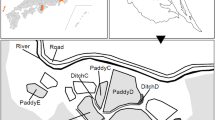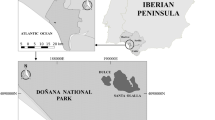Abstract
The population dynamics of Lethocerus deyrollei, including the seasonal change in the habitat utilization, were studied in five types of waters, permanent and temporary pools, ditch, rice paddy and marsh in a Satoyama, the traditional landscape in Japan consisting of mixtures of coppice woodlands, farmlands, and settlements, in northern Osaka, from June, 1999 to December, 2001. A mark and recapture census was carried out with adults, and the stage and the number were recorded in nymphs. A total of 95 adults were numbered, and 48 (51%) were recaptured in all the five water types during the study period. Adults of the new generation appeared from late July, and disappeared before the winter in all types of waters. A total of three overwintered adults were recaptured in permanent and temporary pools, ditch, and paddy from between early April and early June. Densities of both L. deyrollei adults and their prey, tadpoles and frogs, were high in permanent and temporary pools, and ditch, in which water temperatures were high in the summer season. Third to fifth (final) instar nymphs were also observed in all water types with different densities in summer, while first and second instars were found only in permanent pool, ditch and paddy habitats in which water temperatures were high and oviposition substrata such as the rice plant, other hygrophytes and wooden stakes existed. These results show that the traditional water system of paddy in the Satoyama landscape as a whole provides an important habitat for L. deyrollei which is now under threat by changing agricultural practices like other native biota inhabiting the system.
Similar content being viewed by others
References
Chapman (1951) ArticleTitleSome properties of the hypergeometric distribution with applications to zoological censuses Univ. California Public. Stat. 1 131–160
M.J. Cullen (1969) ArticleTitleThe biology of giant water bugs (Hemiptera: Belostomatidae) in Trinidad Proc. R. Soc. Lond. 44 IssueID7–9 123–136
Hashizume H. 1994. In: Miyatake Y. (ed.), All about the Giant Water Bug – Wishes for Symbiosis with Aquatic Animals. Tombo Publishing Co., Osaka, Japan. (in Japanese).
K. Hidaka (1994) ArticleTitleCommon but unusual insects [1]-Faunal diversity in agricultural land The Insectalium 08 240–245
K. Hidaka (1998) ArticleTitleBiodiversity conservation and environmentally regenerated farming system in rice paddy fields Jpn. J. Ecol. 48 167–178
K. Hidaka (2000) ArticleTitleWhat’s happen in the paddy giant water bug. Its conservation and village water sustainability Nat. Insects 35 IssueID9 14–18
T. Hirai K. Hidaka (2002) ArticleTitleAnuran-dependent predation by the giant water bug, Lethocerus deyrollei (Hemiptera: Belostomatidae), in rice fields of Japan Ecol. Res. 17 655–661 Occurrence Handle10.1046/j.1440-1703.2002.00523.x
E.W. Hoffman (1924) ArticleTitleBiological notes on Lethocerus americanus (Leidy.) Psche 31 175–183
E.W. Hoffman (1931) ArticleTitleStudies on bionomics of the water-bug, Lethocerus indicus (Hemiptera Belostomatidae) in China Verhandlung Vereinigungt theoretische angewandte limnologie 5 IssueID2 661–667
H.B. Hungerford (1925) ArticleTitleNotes on the giant water bugs Psyche 32 88–91
N. Ichikawa (1988) ArticleTitleMale brooding behaviour of the giant water bug Lethocerus deyrollei Vuillefroy (Hemiptera: Belostomatidae) J. Ethol. 6 121–127
N. Ichikawa (1989) ArticleTitleRepeated copulation benefit of the female in Lethocerus deyrollei Vuillefroy (Heteroptera: Belostomatidae) J. Ethol. 7 113–117
N. Ichikawa (1990) ArticleTitleEgg mass destroying behaviour of the female giant water bug Lethocerus deyrollei Vuillefroy (Heteroptera: Belostomatidae) J. Ethol. 8 5–11
N. Ichikawa (1991a) ArticleTitleEgg mass destroying and guarding behaviour of the giant water bug, Lethocerus deyrollei Vuillefroy (Heteroptera: Belostomatidae) J. Ethol. 9 25–29
N. Ichikawa (1991b) ArticleTitleAdditional benefit of egg mass detruction by giant water bug, Lethocerus deyrollei Vuillefroy (Heteroptera: Belostomatidae) female J. Ethol. 9 34–36
N. Ichikawa (1993a) ArticleTitleMale brooding water bugs-4. Giant water bug Lethocerus deyrollei (1) Aquabiology 88 353–356
N. Ichikawa (1993b) ArticleTitleBiased operational sex ratio causes the female giant water bug Lethocerus deyrollei to destroy egg masses J. Ethol. 11 151–152
N. Ichikawa (1995) ArticleTitleMale counterstrategy against infanticide of the female giant water bug Lethocerus deyrollei (Hemiptera: Belostomatidae) J. Insect Behav. 8 IssueID2 181–188
N. Ichikawa (2004) ArticleTitleRebirth of abundant natural environment around paddy fields and the successful settlement of giant water bug and other wetland animals Bull. Hoshizaki Green Found 7 137–150
M. Ishii (2001) ArticleTitleStudies on insects and their habitats in the Satoyama in a broader sense Jpn. J. Environ. Entomol. Zool. 12 IssueID4 187–193
InstitutionalAuthorNameJapan Environment Agency (2000) Threatened wildlife of Japan-Red Data Book, 2nd edn Japan Wildlife Research Center Tokyo
Y. Kadono (1998) ArticleTitleDiversity of the flora of Naka-ikemia lowland wetland in Turuga Fukui Prefecture and significance of its conservation Jpn. J. Ecol. 48 163–166
D.A. Lytle (1999) ArticleTitleUse of rainfall cues by Abedus herberti (Hemiptera: Belostomatidae): a mechanism for avoiding flash floods J. Insect Behav. 12 IssueID1 1–12 Occurrence Handle10.1023/A:1020940012775
H. Moriyama (1997) Mura no shizenn wo ikasu (Reviving rural nature) Iwanami-shoten Tokyo
H. Moriyama (1998) ArticleTitleYatsuda paddy fields as the reservoir of hydrophilic fauna Res. J. Food Agricult. 21 IssueID12 15–19
H. Numata H. Hashizume (1997) ArticleTitleEffects of temperature and photoperiod on reproduction in the Giant water bug, Lethocerus deyrollei (Vuillefroy) (Heteroptera: Belostomatidae) Jpn. J. Entomol. 65 IssueID1 55–61
K.P. Rankin (1935) ArticleTitleLife history of Lethocerus americanus (Leidy) (Hemiptera-Belostomatidae) Univ. Kansas Sci. Bull. 22 IssueID15 479–491
L. Smith E. Larsen (1993) ArticleTitleEgg attendance and brooding by males of the giant water bug Lethocerus medius (Guerin) in the field (Heteroptera: Belostomatidae) J. Insect Behav. 6 IssueID1 93–106 Occurrence Handle10.1007/BF01049150
Takeuchi T., Brown R.D., Washitani I., Tsunekawa A. and Yokohari M. (eds) 2003. Satoyama-the traditional rural landscape of Japan.
T. Udagawa (1998) ArticleTitleWhat should we do for the conservation of biological diversity in an ago-ecosystem? Res. J. Food Agricult. 21 IssueID12 9–14
Author information
Authors and Affiliations
Corresponding author
Rights and permissions
About this article
Cite this article
Mukai, Y., Baba, N. & Ishii, M. The water system of traditional rice paddies as an important habitatof the giant water bug, Lethocerus deyrollei (Heteroptera: Belostomatidae). J Insect Conserv 9, 121–129 (2005). https://doi.org/10.1007/s10841-005-3488-z
Received:
Accepted:
Issue Date:
DOI: https://doi.org/10.1007/s10841-005-3488-z




